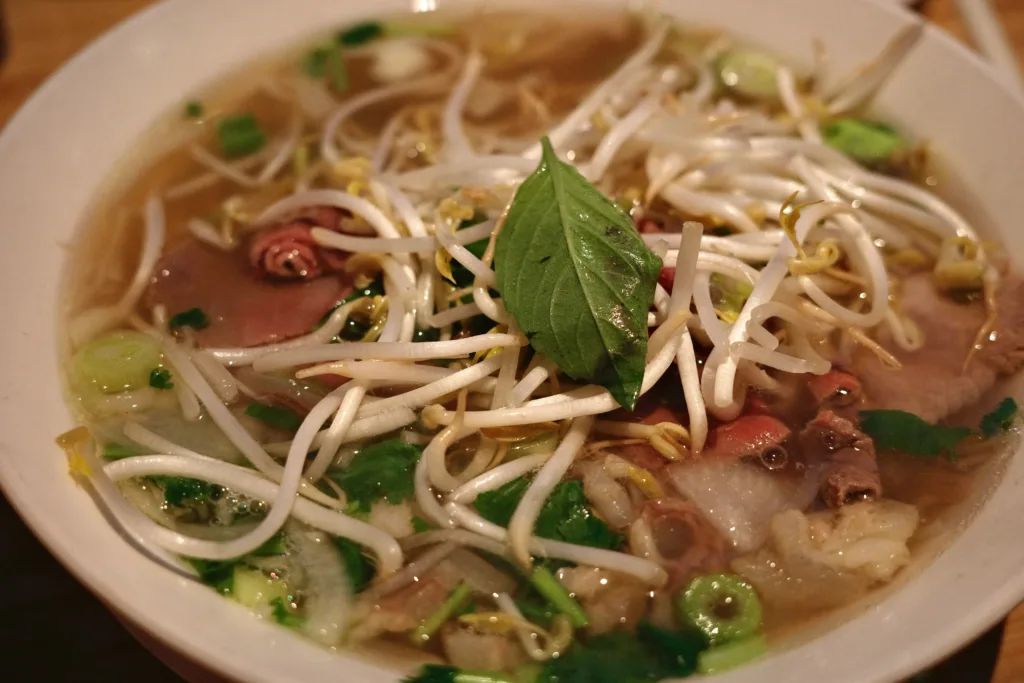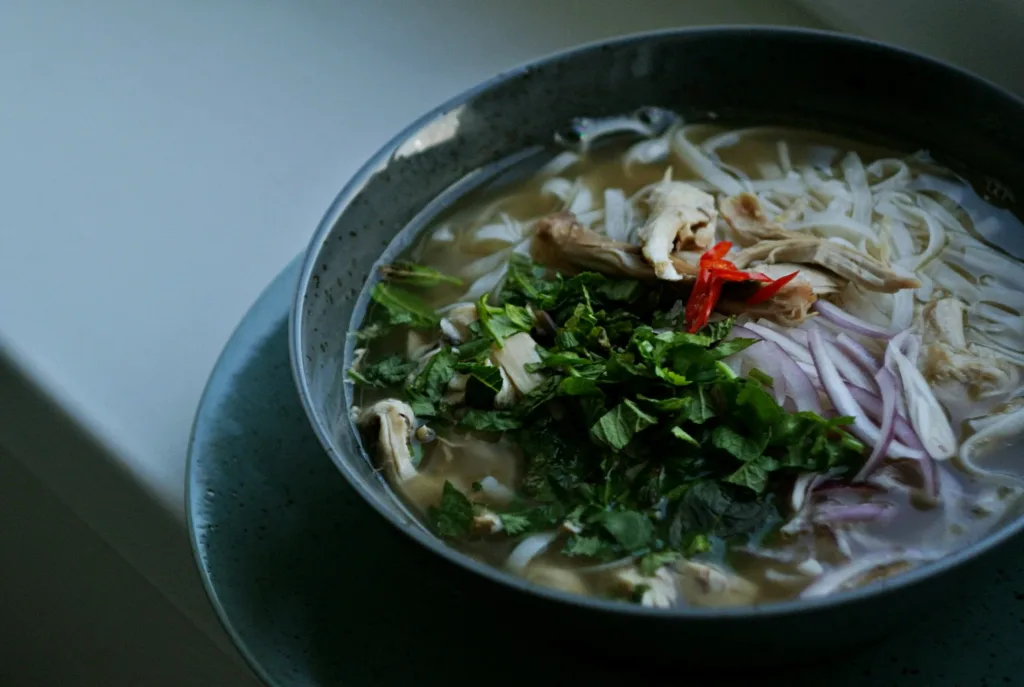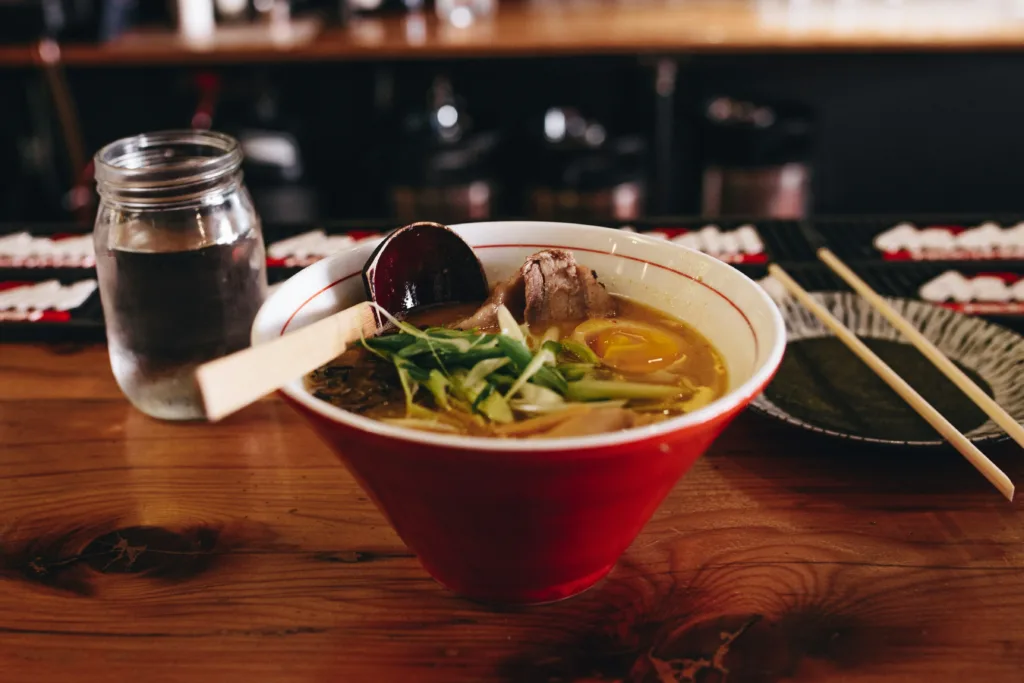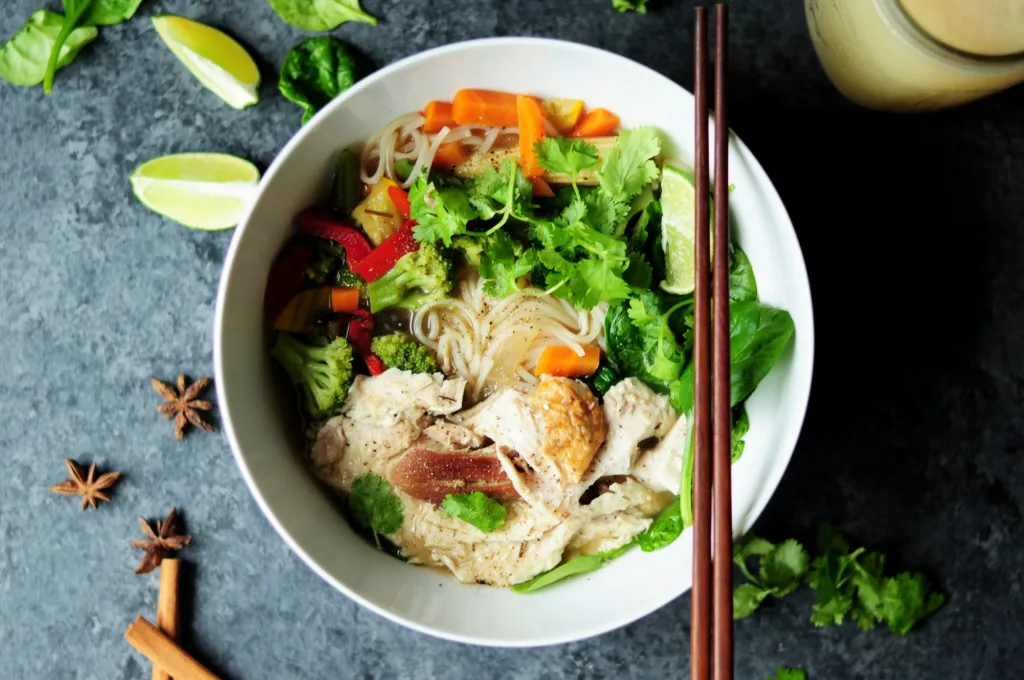Pho is one of those meals that feels like a hug in a bowl – warm broth, soft rice noodles, tender meat, and a handful of herbs that somehow make it all feel fresh. But is it actually healthy, or does it just seem like the better option when you’re scanning a takeout menu? We’ve been there too, wondering if that giant bowl of noodle soup is helping or hurting our nutrition goals. So, we dug into the facts – from calories and protein to sodium, fiber, and what nutritionists really think about eating pho on the regular.
At ReciMe, we’re all about helping you eat well without overcomplicating it. Whether you’re building a meal plan around your favorite Vietnamese dishes or just trying to cut back on sodium, our app makes it easy to stay organized and eat intentionally – without ditching the foods you love. Grab ReciMe now, power up your nutrition, and let’s dig into pho.



What Is Pho Made Of?
Pho (pronounced “fuh”) is one of those meals that somehow hits every craving at once – warm, salty, herby, a little spicy if you want it to be. At first glance, it looks simple. But the flavors come from layers of ingredients that are anything but basic. Here’s what goes into a classic bowl:
Broth
The heart of pho. It’s usually beef or chicken-based, simmered for hours with things like charred onion, ginger, cinnamon, star anise, cloves, and coriander seeds. The result is rich and savory, but not heavy.
Rice noodles
Flat, soft, and naturally gluten-free. They absorb the broth and give the soup its comforting base.
Protein
Traditionally thin-sliced rare beef (pho bo) or shredded chicken (pho ga). Vegetarian versions use tofu or tempeh. Some bowls also come with brisket, tendon, or meatballs if you’re into variety.
Toppings
Thai basil, cilantro, bean sprouts, lime wedges, and chili slices are usually served on the side so you can build your own flavor balance – herbaceous, tangy, crunchy, spicy, or all of the above.
The beauty of pho is that it’s both customizable and consistent. Whether you’re ordering out or making it at home, it’s the kind of dish that manages to feel nourishing and cozy without being too much. One bowl is often enough – but you’ll probably want it again tomorrow.
Nutritional Breakdown of Pho
Pho looks pretty straightforward in the bowl – noodles, broth, protein, herbs – but nutritionally, there’s more going on than you might think. It’s a solid mix of macros with some sneaky benefits (and a few things to watch for if you’re eating it often).
Here’s how it typically breaks down:
- Calories: A regular-sized bowl (about 20–24 ounces) typically contains 450-650 calories, depending on portion size, the noodle-to-broth ratio, and the type of protein used (e.g., lean chicken vs. fatty brisket). Lean chicken pho will run lighter than a fatty brisket combo.
- Protein: Most of the protein comes from the meat or tofu you add. A bowl with beef or chicken can give you around 15–25 g depending on meat, which is great if you’re looking for something filling that supports muscle recovery. It’s one of the reasons pho is a popular post-gym meal.
- Carbs: The rice noodles bring the bulk of the carbohydrates. You’re usually getting closer to 80-110 g, given the rice noodles in large portions. It’s not low-carb, but it’s not outrageous either – especially if you balance it out with veggies.
- Fat: It depends on your protein pick. Chicken breast or tofu keeps the fat low. Go with fatty cuts of beef or a richer broth, and you’ll see that number go up. Nothing wrong with fat – just something to be aware of if you’re watching overall intake.
- Fiber: On its own, pho isn’t a fiber hero. Rice noodles are low-fiber, and unless you’re loading up on veggies, you won’t get much here. That said, tossing in extras like bok choy, broccoli, or carrots can easily fix that.
- Micronutrients: Herbs, spices, and bone broth in pho can contribute small amounts of vitamin A, vitamin C, iron, calcium, and zinc, though the exact quantities depend on the ingredients and portion of vegetables added.

Can You Eat Pho Every Day?
Short answer? You could – but it depends on how you build your bowl.
Pho is one of those meals that walks the line between comfort food and something that actually feels good in your body. It’s warm, hydrating, balanced, and endlessly customizable. So yeah, having it regularly isn’t a bad thing. That said, if you’re eating restaurant-style pho every single day, there are a few things to keep an eye on.
The primary concern is sodium. Some broths, especially pre-made or restaurant versions, can contain over 1,000 mg of sodium per bowl, which is nearly half the recommended daily limit of 2,300 mg, posing a challenge for daily consumption. Over time, it can add up, especially if the rest of your meals are salty too. Making pho at home with a low-sodium broth or dialing back the fish sauce can help a lot.
The other thing is portion size. A big bowl loaded with rice noodles and fatty cuts of beef might leave you feeling sluggish if you’re having it nonstop. But swap in lean protein, add a heap of veggies, and go easy on the noodles? That’s a solid everyday option.
Can you eat pho every day? Yes, if you vary the ingredients, prioritize low-sodium options, and include it as part of a diverse, balanced diet to ensure adequate nutrient variety. It’s not a miracle food, but it’s definitely one of the easier ones to tweak in your favor.
Why Pho Actually Feels So Good: Real Health Benefits
You don’t need a nutrition degree to notice that pho just makes you feel better – especially when you’re under the weather, low on energy, or just need something comforting that isn’t a sugar crash in disguise. But behind that cozy vibe, pho does bring some real health perks when it’s made right.
Here’s what your body actually gets out of it:
- Hydration and electrolytes: The broth isn’t just flavorful – it helps you rehydrate, especially if you’ve been sweating, sick, or just running low on fluids.
- Immune system support: Ingredients like ginger, star anise, and coriander aren’t just for flavor. They’ve got antioxidant and anti-inflammatory properties that can help your immune system do its thing.
- Digestive comfort: Warm broth is easy on the stomach, and spices like ginger can calm nausea or mild bloating. Great for sick days, travel recovery, or just when your gut feels off.
- Lean protein for muscle repair: Whether you go with chicken, tofu, or rare beef, the protein in pho helps repair muscle and keep you full longer.
- Customizable fiber and nutrients: Add in veggies like bok choy, carrots, mushrooms, or spinach and you’ve got extra fiber, vitamins, and minerals with almost no extra calories.
- Naturally gluten-free: Pho can be gluten-free when made with rice noodles and without gluten-containing sauces; always check ingredients like soy sauce, which may contain wheat.
It’s not magic, and it’s definitely not a cure-all, but pho does check a lot of boxes when you’re trying to eat well without overthinking every bite. Comfort food with benefits? We’re into it.

Common Concerns With Eating Pho
Pho’s got comfort food energy and a decent nutritional profile – but it’s not without a few downsides, especially if you’re slurping it on the regular. These aren’t dealbreakers, just things to be aware of if you want to keep pho in your rotation and still eat smart.
Sodium Sneaks Up Fast
The broth brings all the flavor, but it also brings a lot of salt. Some bowls easily hit your daily sodium limit – especially if you’re adding sauces or going back for seconds. It’s not that you need to ditch it entirely, just be aware of what’s in that base.
- Ask for low-sodium broth or go easy on the fish sauce to cut back on salt.
Noodles Can Tip the Scale
Rice noodles are delicious, but they’re carb-heavy and low in fiber. If your bowl’s mostly noodles with a splash of broth and a few herbs, it might not hold you over for long – and the calories add up quicker than you think.
- Try asking for half noodles, half vegetables to keep it more balanced.
It’s Not Always a Fiber Win
Unless you’re loading it with veggies, pho can leave you low on fiber – especially if your bowl’s mostly broth, noodles, and meat. Not a huge issue once in a while, but long term, that can mean less satiety and sluggish digestion.
- Add greens like bok choy or spinach to boost fiber without adding heaviness.
Hidden Calories in Extras
Pho itself can be fairly light, but it’s easy to get sidetracked by the extras – fried rolls, sugary drinks, sweet sauces. These sides sneak in calories fast and don’t always add much in terms of nutrition.
- Skip the fried add-ons or split them with someone to keep your meal in check.

Small Tweaks, Better Bowl: How to Make Pho Healthier
Pho’s already a pretty solid pick, but a few small changes can take it from “decent option” to “legit everyday meal.” The cool part? You don’t have to sacrifice flavor or mess with the whole vibe of the dish. It’s more about making a few smart swaps that keep all the comfort but nudge the nutrition up a notch.
- Choose leaner proteins: Skip the fatty brisket and go for chicken breast, tofu, or thin-sliced eye of round. Still satisfying, just lighter on saturated fat.
- Load up on veggies: Add at least 1-2 cups of bok choy, spinach, mushrooms, or shredded carrots to significantly boost fiber and vitamins, helping you stay fuller without needing a second bowl.
- Dial down the noodles: Ask for a half portion of noodles or swap some of them out for extra greens. You still get the texture without the carb overload.
- Watch the sodium: Ask for low-sodium broth if it’s an option, or make your own at home so you control the salt. Also? You really don’t need that much fish sauce.
- Keep sauces on the side: Hoisin and sriracha are delicious but sugar- and salt-heavy. Use a little if you love the flavor, but don’t treat it like soup.
- Balance the sides: If you’re having spring rolls or something fried, maybe split it or skip it next time. Pho is filling on its own if you build the bowl right.
You don’t have to eat a “perfect” bowl – just one that works for your body and goals. A few tweaks go a long way, and the best part? Pho still tastes like pho. Nothing boring, nothing bland. Just a little more mindful.
Conclusion
Pho isn’t just good comfort food – it’s a legit option when you want something warm, balanced, and actually nourishing. Like anything, though, it depends on how you build it. Go heavy on the broth, lean on the protein, sneak in some extra veggies, and you’ve got a bowl that feels indulgent without wrecking your nutrition goals. We’re not saying it’s a superfood, but if you’re mindful about the sodium and keep the portions reasonable, pho can totally earn a regular spot in your weekly rotation. It’s one of those rare meals that tastes like a treat but still does your body a few favors. And that’s a win in our book.
FAQ
1. Is pho good for weight loss?
It can be, especially if you go light on the noodles, choose lean protein like chicken or tofu, and skip the fried sides. It’s filling without being heavy, and the broth helps you stay hydrated and satisfied.
2. Is pho high in sodium?
It can be, especially with restaurant or store-bought versions. Most of the salt comes from the broth and added sauces like fish sauce or hoisin. If you’re watching your sodium, try making it at home or asking for low-salt broth.
3. Is pho gluten-free?
Yes – traditional pho is usually made with rice noodles, which are naturally gluten-free. Just be cautious of any added sauces or processed ingredients if you’re super sensitive.
4. Is pho healthy when you’re sick?
Absolutely. The warm broth is soothing, the spices like ginger and star anise can help with congestion, and the hydration helps you bounce back faster. It’s basically a gentler, tastier version of chicken soup.
5. Can I eat pho every day?
You could, but it’s smart to switch it up. Watch the sodium, vary your proteins, and don’t overdo it on the noodles. It’s one of those meals that’s healthy when balanced – not when overloaded.
